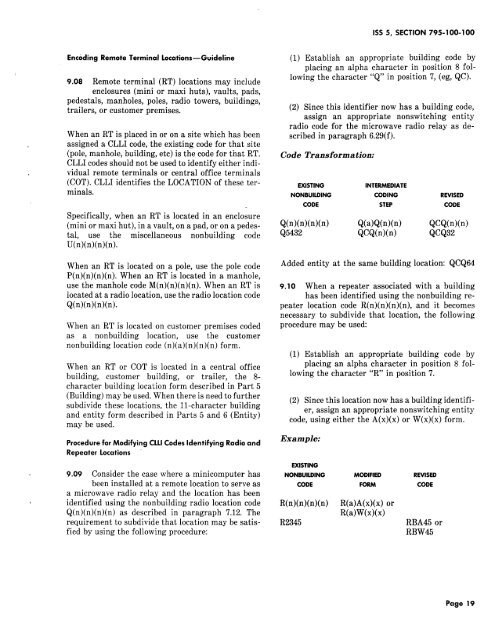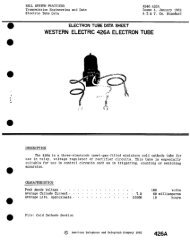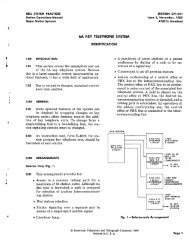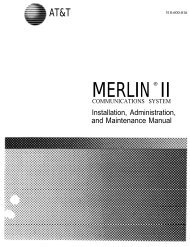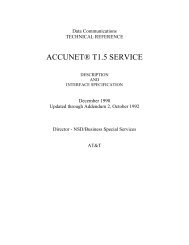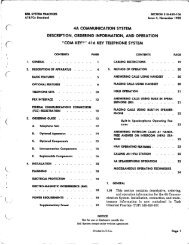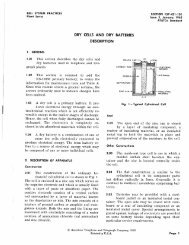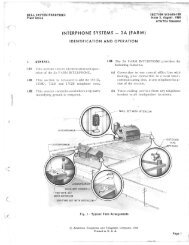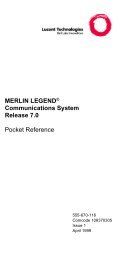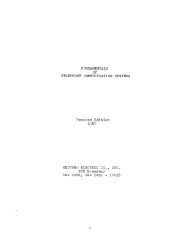COMMON LANGUAGE LOCATION IDENTIFICATION (CLLI) CODE ...
COMMON LANGUAGE LOCATION IDENTIFICATION (CLLI) CODE ...
COMMON LANGUAGE LOCATION IDENTIFICATION (CLLI) CODE ...
Create successful ePaper yourself
Turn your PDF publications into a flip-book with our unique Google optimized e-Paper software.
Encoding Remote Terminal Locations-Guideline<br />
9.08 Remote terminal (RT) locations may include<br />
enclosures (mini or maxi huts), vaults, pads,<br />
pedestals, manholes, poles, radio towers, buildings,<br />
trailers, or customer premises.<br />
When an RT is placed in or on a site which has been<br />
assigned a <strong>CLLI</strong> code, the existing code for that site<br />
(pole, manhole, building, etc) is the code for that RT.<br />
<strong>CLLI</strong> codes should not be used to identify either individual<br />
remote terminals or central office terminals<br />
(COT). <strong>CLLI</strong> identifies the <strong>LOCATION</strong> of these terminals.<br />
Specifically, when an RT is located in an enclosure<br />
(mini or maxi hut), in a vault, on a pad, or on a pedestal,<br />
use the miscellaneous nonbuilding code<br />
U(n)(n)(n)(n).<br />
When an RT is located on a pole, use the pole code<br />
P(n)(n)(n)(n). When an RT is located in a manhole,<br />
use the manhole code M(n)(n)(n)(n). When an RT is<br />
located at a radio location, use the radio location code<br />
Q(n)(n)(n)(n).<br />
When an RT is located on customer premises coded<br />
as a nonbuilding location, use the customer<br />
nonbuilding location code (n)(a)(n)(n)(n) form.<br />
When an RT or COT is located in a central office<br />
building, customer building, or trailer, the 8character<br />
building location form described in Part 5<br />
(Building) may be used. When there is need to further<br />
subdivide these locations, the 11-character building<br />
and entity form described in Parts 5 and 6 (Entity)<br />
may be used.<br />
Procedure for Modifying <strong>CLLI</strong> Codes Identifying Radio and<br />
Repeater Locations<br />
9.09 Consider the case where a minicomputer has<br />
been installed at a remote location to serve as<br />
a microwave radio relay and the location has been<br />
identified using the nonbuilding radio location code<br />
Q(n)(n)(n)(n) as described in paragraph 7.12. The<br />
requirement to subdivide that location may be satisfied<br />
by using the following procedure:<br />
ISS 5, SECTION 795- 1 00-1 00<br />
(1) Establish an appropriate building code by<br />
placing an alpha character in position 8 following<br />
the character "Q" in position 7, (eg, QC).<br />
(2) Since this identifier now has a building code,<br />
assign an appropriate nonswitching entity<br />
radio code for the microwave radio relay as described<br />
in paragraph 6.29(f).<br />
Code Transformation:<br />
EXISTING<br />
NONBUILDING<br />
<strong>CODE</strong><br />
Q(n)(n)(n)(n)<br />
Q5432<br />
INTERMEDIATE<br />
CODING<br />
STEP<br />
Q(a)Q(n)(n)<br />
QCQ(n)(n)<br />
REVISED<br />
<strong>CODE</strong><br />
QCQ(n)(n)<br />
QCQ32<br />
Added entity at the same building location: QCQ64<br />
9.10 When a repeater associated with a building<br />
has been identified using the nonbuilding repeater<br />
location code R(n)(n)(n)(n), and it becomes<br />
necessary to subdivide that location, the following<br />
procedure may be used:<br />
(1) Establish an appropriate building code by<br />
placing an alpha character in position 8 following<br />
the character "R" in position 7.<br />
(2) Since this location now has a building identifier,<br />
assign an appropriate nonswitching entity<br />
code, using either the A(x)(x) or W(x)(x) form.<br />
Example:<br />
EXISTING<br />
NONBUILDING MODIFIED REVISED<br />
<strong>CODE</strong> FORM <strong>CODE</strong><br />
R(n)(n)(n)(n) R(a)A(x)(x) or<br />
R(a)W(x)(x)<br />
R2345 RBA45 or<br />
RBW45<br />
Page 19


